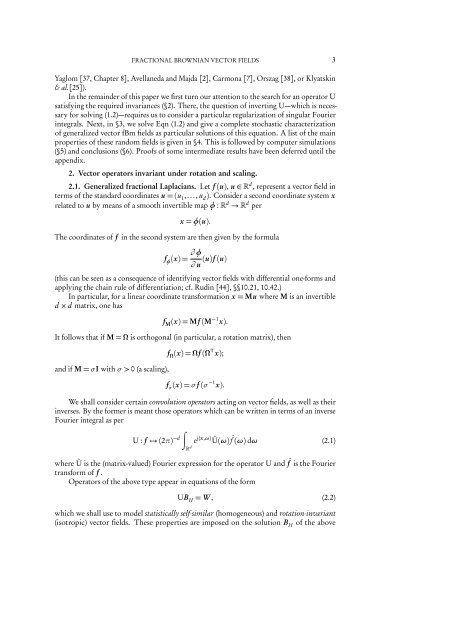FRACTIONAL BROWNIAN VECTOR FIELDS 1. Introduction. A one ...
FRACTIONAL BROWNIAN VECTOR FIELDS 1. Introduction. A one ...
FRACTIONAL BROWNIAN VECTOR FIELDS 1. Introduction. A one ...
You also want an ePaper? Increase the reach of your titles
YUMPU automatically turns print PDFs into web optimized ePapers that Google loves.
<strong>FRACTIONAL</strong> <strong>BROWNIAN</strong> <strong>VECTOR</strong> <strong>FIELDS</strong> 3<br />
Yaglom [37, Chapter 8], Avellaneda and Majda [2], Carmona [7], Orszag [38], or Klyatskin<br />
& al.[25]).<br />
In the remainder of this paper we first turn our attention to the search for an operator U<br />
satisfying the required invariances (§2). There, the question of inverting U—which is necessary<br />
for solving (<strong>1.</strong>2)—requires us to consider a particular regularization of singular Fourier<br />
integrals. Next, in §3, we solve Eqn (<strong>1.</strong>2) and give a complete stochastic characterization<br />
of generalized vector fBm fields as particular solutions of this equation. A list of the main<br />
properties of these random fields is given in §4. This is followed by computer simulations<br />
(§5) and conclusions (§6). Proofs of some intermediate results have been deferred until the<br />
appendix.<br />
2. Vector operators invariant under rotation and scaling.<br />
2.<strong>1.</strong> Generalized fractional Laplacians. Let f (u), u ∈ d , represent a vector field in<br />
terms of the standard coordinates u = (u 1 ,..., u d ). Consider a second coordinate system x<br />
related to u by means of a smooth invertible map φ : d → d per<br />
x = φ(u).<br />
The coordinates of f in the second system are then given by the formula<br />
f φ (x) = ∂ φ<br />
(u)f (u)<br />
∂ u<br />
(this can be seen as a consequence of identifying vector fields with differential <strong>one</strong>-forms and<br />
applying the chain rule of differentiation; cf. Rudin [44], §§10.21, 10.42.)<br />
In particular, for a linear coordinate transformation x = Mu where M is an invertible<br />
d × d matrix, <strong>one</strong> has<br />
f M (x) = Mf (M −1 x).<br />
It follows that if M = Ω is orthogonal (in particular, a rotation matrix), then<br />
and if M = σI with σ > 0 (a scaling),<br />
f Ω (x) = Ωf (Ω T x);<br />
f σ (x) = σ f (σ −1 x).<br />
We shall consider certain convolution operators acting on vector fields, as well as their<br />
inverses. By the former is meant those operators which can be written in terms of an inverse<br />
Fourier integral as per<br />
U : f → (2π) −d ∫ d e j〈x,ω〉 Û(ω) ˆf (ω) dω (2.1)<br />
where Û is the (matrix-valued) Fourier expression for the operator U and ˆf is the Fourier<br />
transform of f .<br />
Operators of the above type appear in equations of the form<br />
UB H = W , (2.2)<br />
which we shall use to model statistically self-similar (homogeneous) and rotation-invariant<br />
(isotropic) vector fields. These properties are imposed on the solution B H of the above
















